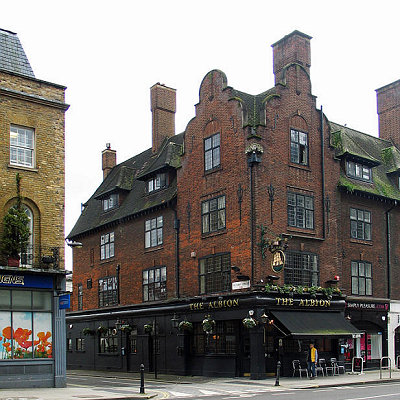
Like us on Facebook
PLACE NAMES


 
|
|
Fulham
|

| |
Fulham (pronounced "Fullum") is part of the London Borough of Hammersmith and Fulham, in southwest London. It is an Inner London district located 3.7 miles (6.0 km) south-west of Charing Cross. It lies on the north bank of the River Thames, between Hammersmith and Kensington and Chelsea, facing Putney and Barnes and is bounded on the east by the West London Line, previously the course of a canal and creek. It was formerly a parish in the County of Middlesex. The area is identified in the London Plan as one of 35 major centres in Greater London. Until 1965 the former Metropolitan Borough of Fulham incorporated the areas of Sands End, Hurlingham, North End (Lillie), Baron's Court (Margravine), West Kensington, Fulham Broadway (Walham), 'Munstervillage' (Town) and along Fulham Palace Road. Fulham Palace, now a museum, served between 1900 and 1976 as the official residence of the Bishops of London.
Fulham has a history of industry and enterprise dating back to the 15th-century, in the shape of its Mill at Millshot, on the south-side of what is now Fulham Palace Road. This was followed by pottery, tapestry-weaving (the Gobelins Manufactory had established a branch in London in the 1700s), paper-making and brewing in the 17th and 18th-centuries all in the area of present-day Fulham High Street. The next two centuries saw involvement with energy production, transportation, the automotive industry, including early aviation and food production, (MacFarlane Lang Biscuits) and laundries.
The Lillie Bridge Depot a railway engineering and stabling depot, opened 1872, heralded the arrival of the railway transport boom in London and was closely involved with the building and extensions of the London Underground network in the capital. It was associated with the electrification of the tube lines from the nearby Lots Road Power Station, just over the borough border in Chelsea and for well over a century, it has been the maintenance hub for the rolling stock and track. It is to be decommissioned by 2019.
In contrast to its modest post-World War II reputation, Fulham is now considered among the "prime" London areas by estate agents. Two football clubs, the eponymous Fulham F.C. and Premier League rivals, Chelsea F.C., are situated within Fulham. There are two exclusive sporting clubs, The Hurlingham Club known for Polo and the Queen's tennis club known for its annual pre-Wimbledon Tennis tournament. In the 1800s Lillie Bridge Grounds, (currently beneath the rising 'Lillie Square' residential development), hosted the first meetings of the Amateur Athletic Association of England, the second FA Cup Final and the first ever amateur boxing matches. The Lillie Bridge area was also the former home-ground of the Middlesex County Cricket Club, before it moved to Marylebone.
Fulham, or in its earliest form "Fulanhamme", is thought to have signified the place either "place of fowls" or "of mud" (which probably had to do with the fact that the River Thames would flood it periodically), or alternatively, "land in the crook of a river bend belonging to an Anglo Saxon chief named Fulla". The manor of Fulham is said to have been given to Bishop Erkenwald about the year 691 for himself and his successors in the See of London. In effect, Fulham Palace, for nine centuries the summer residence of the Bishops of London, is the manor of Fulham. In 879 Danish invaders, sailed up the Thames and wintered at Fulham and Hammersmith. Raphael Holinshed relates that the Bishop of London was lodging in his manor place in 1141 when Geoffrey de Mandeville, riding out from the Tower of London, took him prisoner. During the Commonwealth the manor was temporarily out of the bishops' hands, having been sold to Colonel Edmund Harvey.
In recent years there has been a great revival of interest in Fulham's earliest history, due almost entirely to the efforts of the Fulham Archaeological Rescue Group. This has carried out a number of interesting digs, particularly in the vicinity of Fulham Palace, which show that approximately 5,000 years ago Neolithic people were living by the riverside and in other parts of the area. Excavations have also revealed Roman settlements during the third and fourth centuries AD.
|
 Feel free to Email me any additions or corrections Feel free to Email me any additions or corrections
LINKS AVAILABLE TO YOUR SITE
| |





